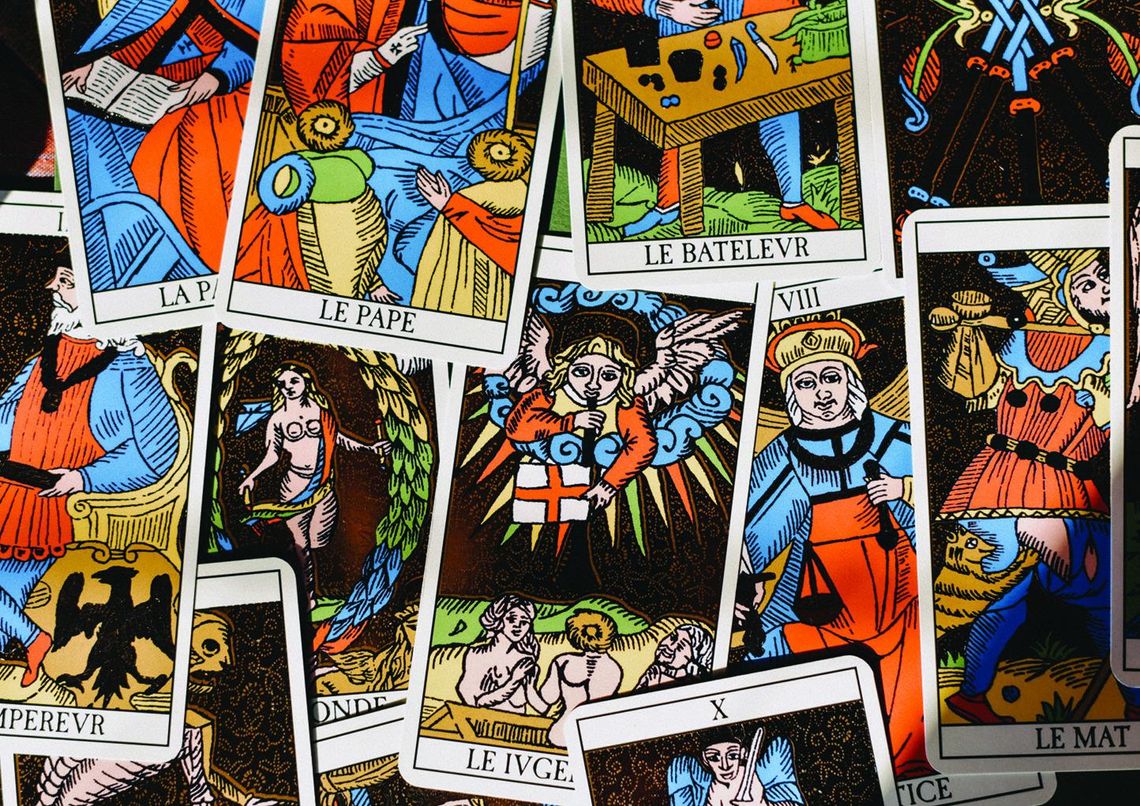Q.I made an appointment to have my cards read, but I want more information about them. What are tarot cards and what is their history?
A. “The Encyclopedia of Occultism & Parapsychology,” edited by Leslie Shepard, defines tarot as a “French name for a special pack of playing cards popularly used for the purpose of divination, and still immensely popular with modern fortune tellers.” While the tarot started out as a game, it is popularly used for cartomancy or “fortune telling.”
The derivation of the word tarot is still uncertain, but there are clues. The word “tarot” and German Tarock derive from the Italian Tarocchi, the origin of which is uncertain, although taroch was used as a synonym for foolishness in the late 15th and early 16th centuries. Tarot cards form part of an ordinary pack in countries of southern Europe and the name tarochi is given to an Italian game. One suggestion is that these cards were called “tarot” because there were patterns or tarotees on the back. They were marked on the back with plain or dotted lines crossing diagonally. Some confirmation of this theory is indicated by the German form of the word - a tarock-karte is a card checkered on the back. However, this may be simply a confusion between cause and effect.
In its familiar form, the tarot pack consists of a pack of 78 cards, comprising four suits of 14 cards each (the extra court card in each suite being the Cavlier, Knight or Horseman) and 22 symbolical picture-cards as atouts or trumps. The four suites, related to the modern hearts, clubs, diamonds and spades, are swords, cups, coins, and batons (earlier represented as swords, cups, rings, and wands).
Much controversy surrounds the whole question of the origins of tarot and its relationship to the present-day set of 52 playing cards. It is not difficult to see symbolic interpretations of the 52 weeks and the symbolic rulers of the court of cards. Some writers have connected tarot with ancient Eastern origins of the game of chess with its comparable king, queen and knight. Others have confidently suggested an origin in ancient Egypt as an esoteric book of life. The idea that the tarot was introduced into Europe by the gypsies appears to have been first suggested by J.F. Valliant, who had lived for many years among the gypsies and had been instructed in their traditional lore. Much of the information thus obtained was incorporated in his nineteenth century books. Vaillant’s theory was endorsed by the French writer “Papus” (Gerard Encausse) in his book “Le Tarot des Bohemiens: Le plus ancient libre du Monde” (“The Tarot of the Bohemians: The Oldest Book in the World”), in which he claimed that the tarot was the absolute key to occult science.
There are many ways of consulting the cards for divination, but they mostly involve laying out the cards after shuffling and interpreting the indications of the major symbolic cards in their relationship to each other. The library has books that go into detail regarding interpretation. “The Tarot Handbook,” by Hajo Banzhaf, includes a section on interpretations and additional systems of laying the cards out. There are specific guides and interpretations for specific cards. The pattern for which the cards are lain out also affect the interpretation. In addition to different ways of laying out the cards, there are different packs, depending upon different traditions and there are also newly designed packs from a modern period. The Rider-Waite is the most popular deck. First drawn in 1909 by Pamela Colman Smith under the direction of Arthur Edward Waite, this deck offers vibrant and classic interpretations of each major and minor arcana card.
For more information about the tarot, check out the following books from the library:
• “Tarot – part of the Ciencia y Prediccion” (found in the Spanish Language collection)
• “Finding the Fool: a Tarot Journey to Radical Transformation” by Meg Wall Jones
• “Tarot for Change: Using the Cards for Selfcare, Acceptance, and Growth” by Jessica Dore
• “Tarot: Beyond the Basics Gain a Deeper Understanding of the Meanings Behind the Cards” by Anthony Louis
Suzanne Sanders is the columnist for the library. She is the Community Services Manager for the San Marcos Public Library and came from the Austin Public Library in 2015 after having served there as a librarian for over 20 years. She gratefully accepts your questions for this column.








